Introduction
Brand Development Index (BDI) is a critical factor in the marketing world that many businesses tend to overlook. It is a powerful tool that provides valuable insights into the effectiveness of marketing campaigns and the potential of different markets. Simply put, BDI measures the market share of a brand in a given market relative to the size of that market. By measuring a brand’s BDI score, marketers can analyze which markets are more favorable for their products and services, and what marketing efforts work best to improve their brand’s market share.
In today’s competitive world, marketers have a vast array of choices when it comes to advertising and promoting their products, from traditional media like print, radio and TV, to digital channels like social media, content marketing, and email. With the plethora of marketing channels available, businesses need to use data-driven insights to inform their marketing decisions and ensure that their campaigns are not only effective but also efficient. This is where the Brand Development Index comes in.
Definition of Brand Development Index (BDI)
The Brand Development Index (BDI) is a statistical tool used in marketing analysis that helps businesses to understand how effectively their brand is reaching its potential customers in a particular market. The BDI (Brand Development Index) measures the relative sales performance of a brand in a market as compared to the size of that market. It is used to evaluate a brand’s sales potential or sales success within a specific market area.
BDI is an essential marketing metric that enables businesses to determine which market demographics are the most viable for their products or services. It also measures a brand’s market penetration and identifies areas where the brand has lower sales potential.
Importance of BDI in marketing
BDI provides a critical understanding of the performance of various marketing campaigns and their impact on a brand’s market share. By tracking a brand’s BDI (Brand Development Index) score over a period, businesses can monitor their brand’s growth in a market and the effectiveness of their marketing strategies.
BDI is also an effective tool for market segmentation. By using BDI ( scores, businesses can identify the markets where their brand is overperforming and underperforming. This data helps them determine which marketing channels to invest in and which to avoid.
Moreover, BDI enables businesses to assess the competitiveness of their products or services within a specific market. By analyzing BDI (Brand Development Index) scores of their brand and competitors in a market, businesses can determine their competitive strengths and weaknesses. By concentrating on their strengths, they can develop marketing campaigns and strategies that will differentiate them from their competitors.
In recent years, the importance of BDI (Brand Development Index) has increased significantly in the digital marketing space. As social media platforms have become more prevalent, marketers need to analyze their BDI scores in new ways. By tracking a brand’s social media activity and engagement levels, businesses can determine how much of their marketing resources they need to allocate to social media campaigns.
Understanding BDI
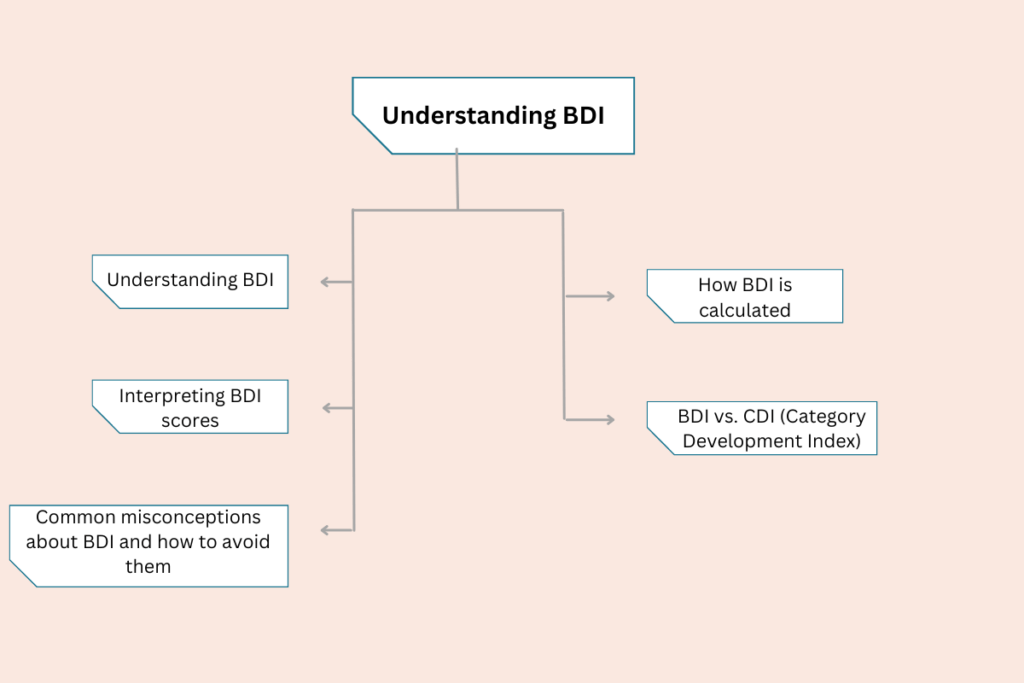
Understanding BDI
Brand Development Index (BDI) as we have discussed previously is a powerful tool that helps businesses to identify the attractiveness of different markets for their products or services. BDI (Brand Development Index) is calculated by comparing the percentage of a brand’s sales in a particular market to the percentage of the population in the market. It is an indicator that measures the sales potential of a given market and enables businesses to prioritize their marketing resources more effectively. In this section we will dig deeper into how arrive at a BDI Score
How BDI is calculated
BDI is calculated using the following formula:
BDI = (Brand Sales in Market / Category Sales in Market) x 100
To calculate BDI, businesses need to determine both the brand sales and category sales figures for a specific market. They can then use the above formula to derive a BDI (Brand Development Index) score that indicates the brand’s sales potential in that market relative to the size of the market.
Interpreting BDI scores
BDI scores typically range from 0 to 200. A BDI score of 100 is considered average, meaning that the brand’s sales in the market are consistent with the size of the market’s population. If the BDI (Brand Development Index) score is above 100, it indicates that the brand is performing better than average in that market, while a score below 100 suggests that the brand is underperforming in the market.
For example, if a company has a BDI score of 150, it means their brand is overperforming in that market by 50% compared to the general population.
BDI vs. CDI (Category Development Index)
Another important index used in marketing analysis is the Category Development Index (CDI). CDI measures the sales potential of a product category in a specific market. It is calculated as:
CDI = (Category Sales in Market / Population in Market) x 100
CDI measures the potential of a particular product category to sell in a particular market. On the other hand, BDI measures the effectiveness of a particular brand in a given market.
By comparing BDI and CDI scores, businesses can understand how strongly their brand is positioned within a broader market category. High BDI (Brand Development Index) and CDI scores indicate that the brand is well-positioned and has good market potential.
Common misconceptions about BDI and how to avoid them
While BDI is a powerful marketing tool, it is often misunderstood and misinterpreted. Here are some common misconceptions about BDI:
– Misconception: A BDI score above 100 indicates a profitable market.
– Reality: A BDI score above 100 only indicates that the brand is performing better than average in a particular market. It does not necessarily mean that the market is profitable for the brand.
– Misconception: BDI is only relevant for large brands and companies.
– Reality: BDI can be used by businesses of all sizes to identify potential markets and develop marketing strategies.
– Misconception: BDI is a static metric that does not change over time.
– Reality: BDI is dynamic and can change over time as markets evolve and new products are introduced. Businesses need to monitor BDI scores regularly to stay informed.
To avoid these misconceptions, businesses should use BDI (Brand Development Index) in conjunction with other marketing metrics and conduct careful analysis to fully understand the market potential and effectiveness of their marketing campaigns.
Understanding the Concept of Brand Development Index
Sure, let’s create a hypothetical brand named “Sunny Shades”. Sunny Shades is a brand that sells sunglasses for both men and women.
BDI (Brand Development Index), which stands for Brand Development Index, measures the potential of a brand in a specific market area. It is calculated by dividing the percentage of a brand’s sales in a particular market area by the percentage of the population in that same market area.
Here is an example of BDI calculation for Sunny Shades
Assuming that Sunny Shades has 10% of the total market share for sunglasses in a specific market area, with a population of 1 million. And the total annual sales for all sunglasses in that market are $1 million.
– To calculate the percentage of the sales, we need to divide the annual sales of Sunny Shades by the total annual sales of the market.
Sunny Shades sales = $100,000 (10% of $1,000,000)
– To calculate the percentage of population, we need to divide the market population by the total population.
Market Population = 100,000 (10% of 1,000,000)
– BDI calculation: Sunny Shades BDI = (Sunny Shades sales / market sales) × 100 / (market population / total population) = ($100,000/$1,000,000) x 100 / (100,000/1,000,000) = 10.
Therefore, Sunny Shades BDI is 10 in this particular market. This means that Sunny Shades has a moderate brand development potential in this market area, as its sales are equal to its market share.
Benefits of Using BDI
Benefits of Using BDI
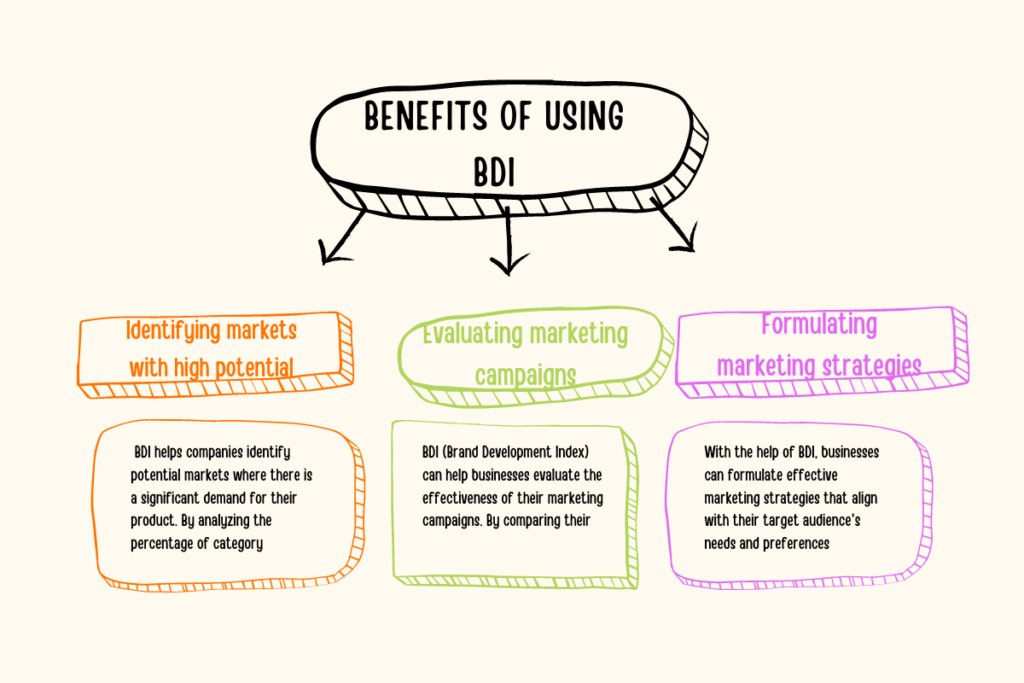
Identifying markets with high potential: BDI helps companies identify potential markets where there is a significant demand for their product. By analyzing the percentage of category sales in a particular market, businesses can understand their market position and how best they can penetrate the market.
Evaluating marketing campaigns: BDI (Brand Development Index) can help businesses evaluate the effectiveness of their marketing campaigns. By comparing their BDI score before and after the campaign, they can determine whether their promotional efforts have brought about a significant increase in sales.
Formulating marketing strategies: With the help of BDI, businesses can formulate effective marketing strategies that align with their target audience’s needs and preferences. Based on the BDI score, marketers can allocate more resources to markets with higher potential and design campaigns that resonate well with consumers.
Tips for Improving Your BDI Score
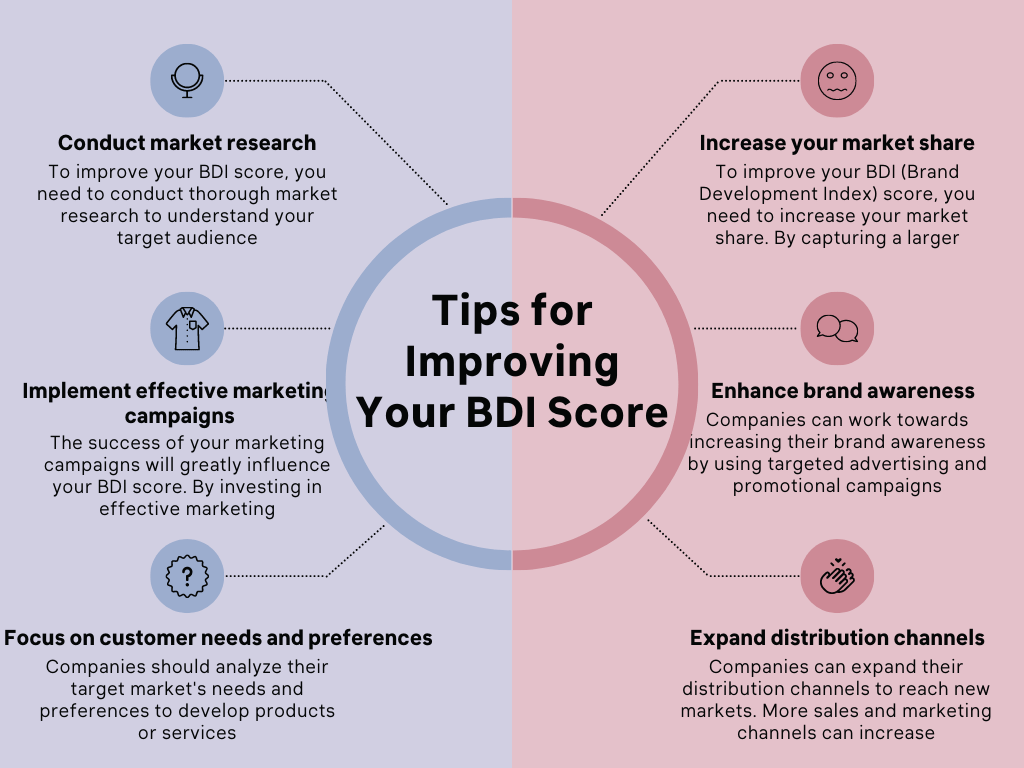
Conduct market research: To improve your BDI score, you need to conduct thorough market research to understand your target audience and their preferences. By knowing what your customers want, you can tailor your marketing efforts to meet their specific needs.
Increase your market share: To improve your BDI (Brand Development Index) score, you need to increase your market share. By capturing a larger portion of the market, you can leverage economies of scale to lower costs and increase your profits.
Implement effective marketing campaigns: The success of your marketing campaigns will greatly influence your BDI score. By investing in effective marketing strategies that resonate well with your target audience, you can increase sales and improve your BDI score.
Enhance brand awareness: Companies can work towards increasing their brand awareness by using targeted advertising and promotional campaigns. This can lead to a higher BDI score.
Focus on customer needs and preferences: Companies should analyze their target market’s needs and preferences to develop products or services that are a perfect fit for them. This can result in a higher BDI score due to increased demand.
Expand distribution channels: Companies can expand their distribution channels to reach new markets. More sales and marketing channels can increase brand exposure and potentially increase a company’s BDI score.
Case Study: Using BDI in Action
A hypothetical company, ABC Ltd, has recently launched a new product, “XYZ,” and wants to determine which markets have the highest potential to sell the product. After analyzing sales data from different regions, the company calculated the BDI score for each region. The BDI (Brand Development Index) scores were as follows:
Region A – BDI score of 85%
Region B – BDI score of 55%
Region C – BDI score of 70%
Based on the BDI scores, the company identified region A as the region with the highest potential for their product. The company then directed more sales and marketing efforts towards this region. As a result, the company’s sales in region A increased, and their overall market share grew.
Key takeaways from the case study
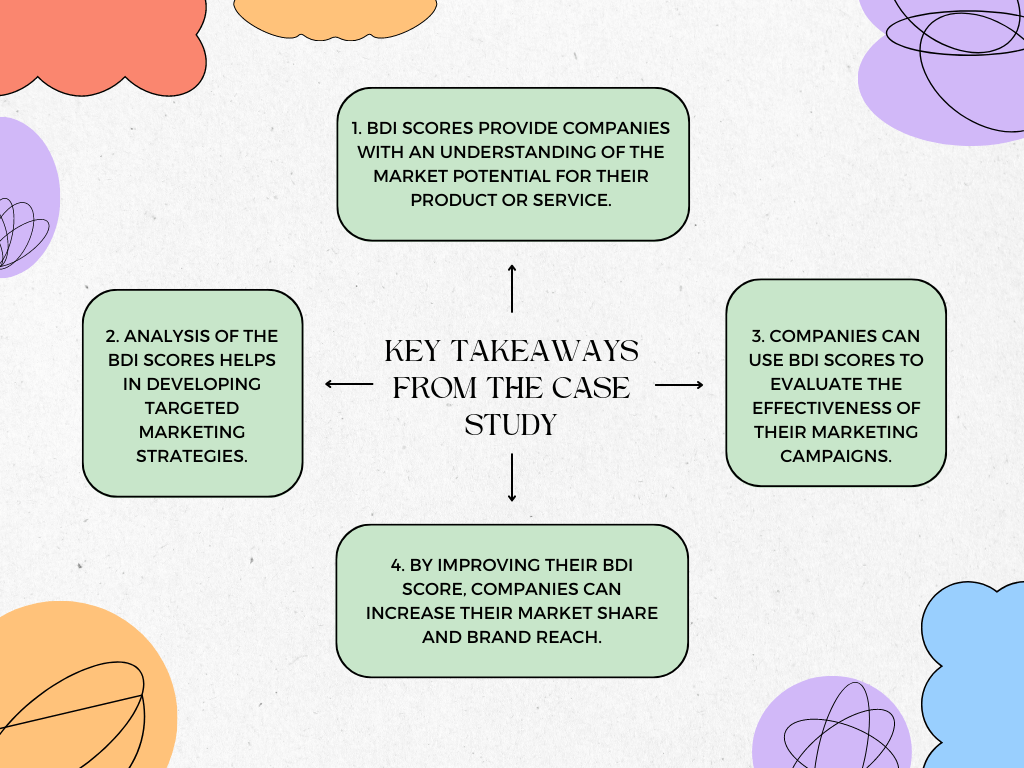
1. BDI scores provide companies with an understanding of the market potential for their product or service.
2. Analysis of the BDI scores helps in developing targeted marketing strategies.
3. Companies can use BDI scores to evaluate the effectiveness of their marketing campaigns.
4. By improving their BDI score, companies can increase their market share and brand reach.
Limitations of BDI
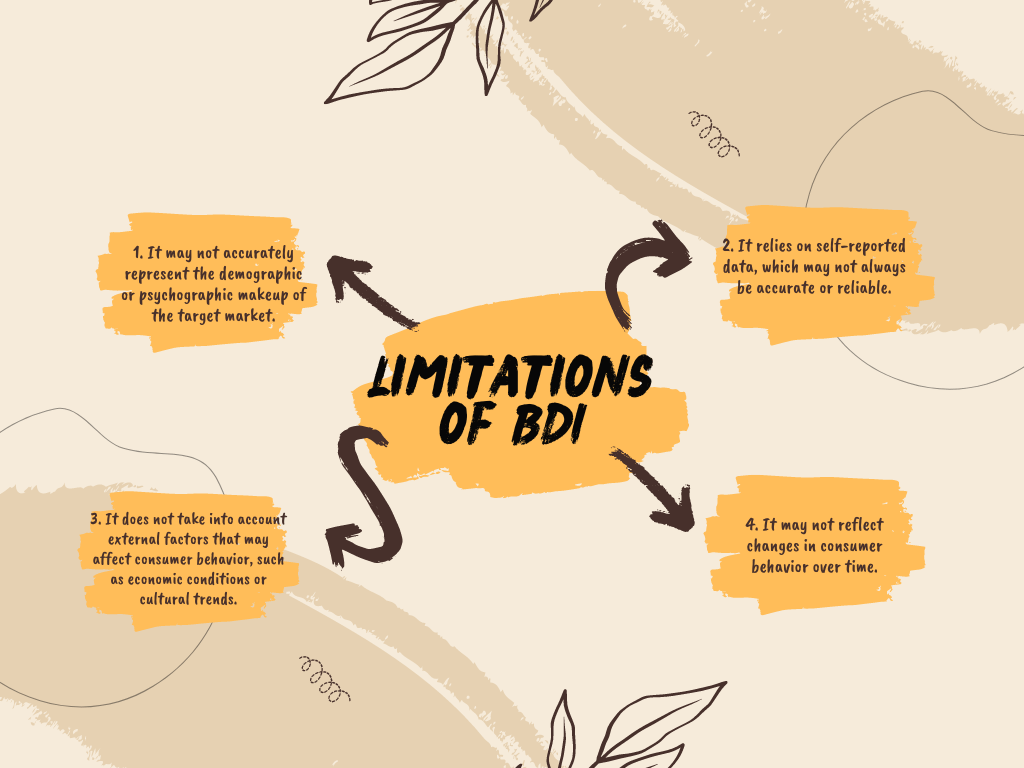
1. It may not accurately represent the demographic or psychographic makeup of the target market.
2. It relies on self-reported data, which may not always be accurate or reliable.
3. It does not take into account external factors that may affect consumer behavior, such as economic conditions or cultural trends.
4. It may not reflect changes in consumer behavior over time.
Factors that can impact BDI accuracy

1. Sampling error or bias in data collection.
2. Changes in population demographics or consumer behavior.
3. Differences in product availability or marketing strategies in different geographic regions.
4. Inaccurate or incomplete sales data.
Using BDI in conjunction with other metrics
BDI (Brand Development Index) can be a useful tool in conjunction with other metrics, such as brand awareness, consumer sentiment, or customer loyalty, to gain a more comprehensive understanding of consumer behavior and market trends. By combining different metrics, companies can gain a more accurate and nuanced view of their target market and make more informed decisions about marketing and product development.
Examples of industries and products that are well-suited for BDI analysis
BDI analysis can be useful for many industries and products, but some are particularly well-suited to this approach. One example is the consumer packaged goods industry, which includes products that are frequently purchased and consumed by a wide range of consumers. These products include food and beverages, household cleaning supplies, and personal care items. BDI (Brand Development Index) analysis can help companies in this industry understand which geographic regions and demographic groups are driving sales of their products, and adjust their marketing strategies accordingly.
Another industry that can benefit from BDI analysis is the retail industry. This includes both brick-and-mortar stores and e-commerce retailers. By analyzing BDI data, retailers can gain insights into which products are most popular in different regions and among different target audiences. This information can help them to optimize their product offerings, marketing strategies, and pricing strategies, in order to maximize sales and profitability.
A third example of an industry well-suited for BDI analysis is the automotive industry. Whether they are selling cars, trucks, or other vehicles, automobile manufacturers and dealerships need to understand which geographic regions and demographic groups are most interested in their products. BDI (Brand Development Index) analysis can help companies in this industry to identify these target audiences and develop marketing campaigns that are tailored to their specific needs and preferences. By using BDI (Brand Development Index) analysis and other metrics to understand their customers better, automotive companies can succeed in a competitive marketplace and build long-lasting relationships with their customers.
How BDI fits into a broader market segmentation strategy
BDI (Brand Development Index) is one of several metrics and tools that companies can use as part of a broader market segmentation strategy. Market segmentation involves dividing a larger market into smaller groups, or segments, based on shared characteristics such as demographics, geographic location, psychographics, and behaviors. By doing so, companies can develop targeted marketing strategies that speak directly to the needs and preferences of each segment, and ultimately improve the effectiveness and ROI of their marketing efforts.
BDI analysis can play a key role in this process. By measuring the relative sales performance of a product in different geographic regions, BDI (Brand Development Index) data can help companies identify which regions or markets are underserved or overlooked and therefore represent potential growth opportunities. This data can also be used in combination with other segmentation criteria, such as demographic data, to identify specific target audiences within each market that may be particularly receptive to a certain product or marketing message.
By incorporating BDI analysis and other segmentation strategies into their marketing efforts, companies can create more targeted and effective campaigns, and ultimately improve their bottom line. For example, a company might use BDI analysis to identify a geographic region where sales of their product are lagging. They could then use demographic data to identify the age, income, and other characteristics of the consumers in that region, and build a targeted marketing campaign that speaks directly to those consumers’ needs and preferences. As a result, the company is more likely to achieve a higher ROI on their marketing investment, and ultimately increase sales and profitability.
Conclusion
The Brand Development Index (BDI) is a powerful tool that helps companies understand how well their products are performing in different geographic regions, and where they may be able to uncover opportunities for growth. By measuring the relative sales performance of a product in different markets, BDI data can help companies tailor their marketing strategies to specific target audiences, investment decisions, and increase product sales. This, in turn, can help them improve profitability, increase market share, and outperform competitors.
However, as with any metric, BDI has limitations, and should be used in conjunction with other metrics and tools as part of a broader market segmentation strategy. Companies that use BDI in conjunction with other segmentation criteria, such as demographics, psychographics, and behavioral data, can gain a more nuanced understanding of their target audience and develop more effective marketing campaigns. By leveraging BDI analysis as part of a broader market segmentation approach, companies can gain a competitive advantage, strengthen their relationships with customers, and drive long-term growth and success.
Samrat is a Delhi-based MBA from the Indian Institute of Management. He is a Strategy, AI, and Marketing Enthusiast and passionately writes about core and emerging topics in Management studies. Reach out to his LinkedIn for a discussion or follow his Quora Page
